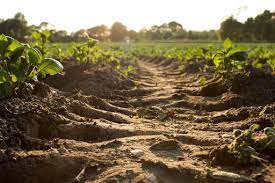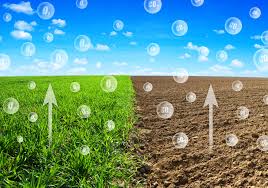Soil quality in its simplest terms is how well a soil is doing what we want it to do. The definition of soil quality adopted by the Soil Science Society of America is the capacity of a specific kind of soil to function, within natural or managed ecosystem boundaries, to sustain plant and animal productivity, maintain or enhance water and air quality, and support human health and habitation.
The definition of soil quality includes two aspects: the inherent properties of soil and the effect of human use and management on the ability of the soil to function. The inherent properties of the soil establish the basis from which to set expectations for a specific soil to function.
Evaluation of changes in soil quality is based on whether management has enhanced, sustained, or degraded the ability to provide the chosen service, without adverse effects on its surroundings.
Soil provides the following basic functions or services:
Controlling waterflow.Soil helps control where rain, snowmelt, and irrigation water goes. Water and dissolved solutes flow either over the soil surface or into and through the soil profile.
Sustaining plant and animal productivity.The diversity and productivity of living things depends on soil. This includes not only crops, but also soil biota such as earthworms and microbes that are beneficial for sustained crop production.
Filtering potential pollutants. The minerals and microbes in soil are responsible for filtering, buffering, degrading, immobilizing, and detoxifying organic and inorganic materials, including industrial and municipal by-products and atmospheric deposits.
Cycling nutrients. Carbon, nitrogen, phosphorus, and many other nutrients are stored, transformed, and cycled through the soil.
Supporting structures. Soils provide a stable medium for plant root growth with sufficient porosity to allow solute flow and aeration. For land uses other than crop production, buildings need stable soil for support, and archeological treasures associated with human habitation are protected in soils.
Soil Organic Carbon as an Indicator of Soil Quality
The key to managing for improved soil quality for purposes of crop production is to manage for soil organic matter. Soil organic matter is the organic faction of the soil including plant and animal residues, soil organisms, and many combinations of chemical elements.
Much of the soil organic matter consists of the element carbon. Carbon is key, because we have the ability to manipulate it, and it has a major role in physical, chemical, and biological properties of soil.
Read Also : Maintenance of Soil Nutrient Guide
Managing Soil Organic Carbon to Enhance Soil Quality

Managing for carbon includes adding organic material such as manure and managing crop residues through reduced tillage, crop rotations, and cover crops. Through microbial breakdown of residues and other natural processes, soil carbon accumulates in the soil.
The soil’s structure improves through greater aggregation produced by water insoluble proteins and other organic products from the breakdown of residues that bind smaller particles together.
This improved aggregation further resists the impacts of rainfall and enhances infiltration, providing more water for plant growth and less for runoff. The reduction in runoff improves water quality by reducing sediment and nutrient loads and increasing the use of the soil as a natural filter.
Organic matter removes contaminants from the environment through strong chemical bonds with the soil, rendering the contaminants harmless, or degrading the contaminants to less toxic forms.

A soil’s ability to retain water is enhanced by the chemical nature of organic matter, which can hold from 10 to 1,000 times more water than inorganic soil matter.
Change in soil organic carbon is an indicator of soil quality. Cropland soils that are increasing in soil organic carbon over time will have an increased capacity to sustain plant and animal activity retain and hold water, filter potential pollutants, and cycle nutrients, that is, enhanced soil function.
However, not all cropland soils that are losing soil organic carbon are in a degraded state with respect to soil function. Loss of soil organic carbon is much less serious for cropland acres with inherently high levels of soil organic carbon than for acres with inherently low levels of soil organic carbon.
Some soils with relatively high percent losses can continue to lose soil organic carbon for many years before soil function is impaired. Other soils, on the other hand, may only be able to tolerate very small percent losses before soil function is impaired.
In summary,water and wind erosion are major factors contributing to the loss of nutrients. Losses may be greater in high-input systems, or where rainfall is very high.
Water barriers, such as grass strips and stone rows, are effective options to reduce erosion and to keep applied fertilizer and manure in place.
Erosion and runoff can also be reduced by covering the soil with a mulch layer of living or dead biomass. Soil mulch reduces water speed, avoids crust formation and improves soil porosity and infiltration rates.
Nutrients added as mineral fertilizer, recycled in crop residues and manure as well as soil nutrient stocks may be lost from the farming system or the farm plot through water or wind erosion, leaching or gaseous losses.
Nitrogen is the most susceptible to losses because it is very mobile and can be lost due to leaching as well as volatilization. Therefore, management practices that will check erosion, leaching and volatilization should always be adopted in our croplands.
With good management practices, a significant proportion of nutrients added to the farming system in the form of mineral fertilizers or crop residues and manure can be recycled many times through crops and livestock.
Some nutrients taken up by the crop are exported in crop products (grain, tubers) that are exported from the farm but a large part of nutrients taken up by crop plants can be recycled back to the soil in the form of crop residues.
Read Also : Products that Can be Derived from Agricultural Waste
Frequently Asked Questions
We will update this section soon.

